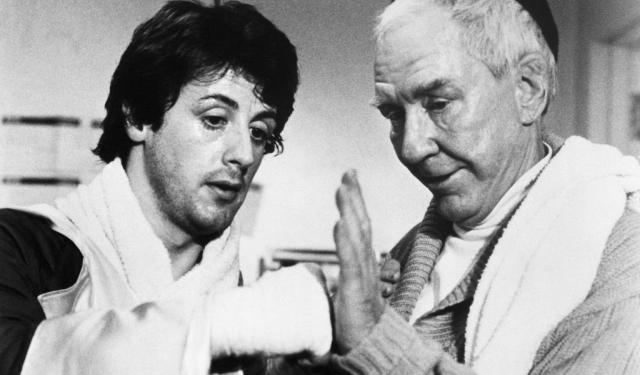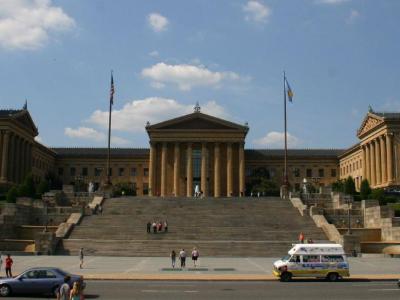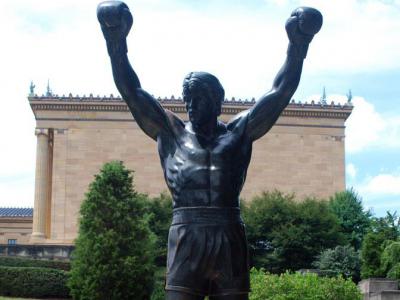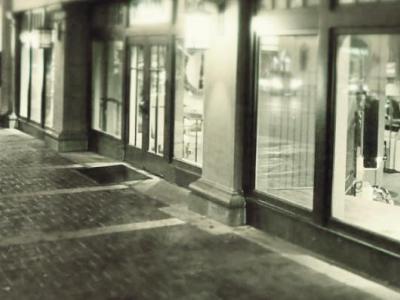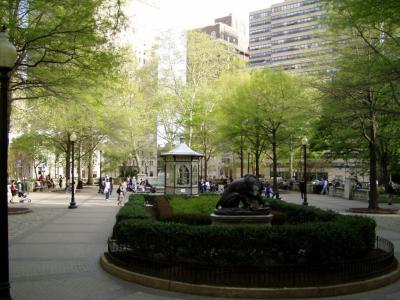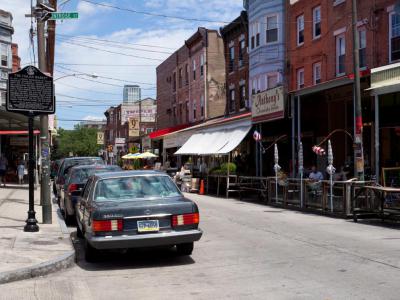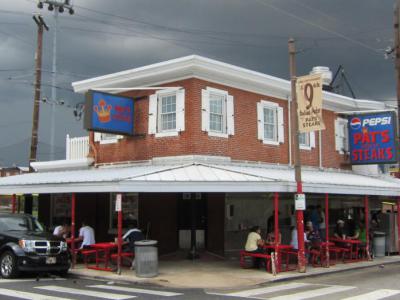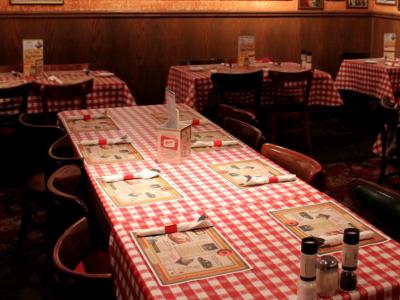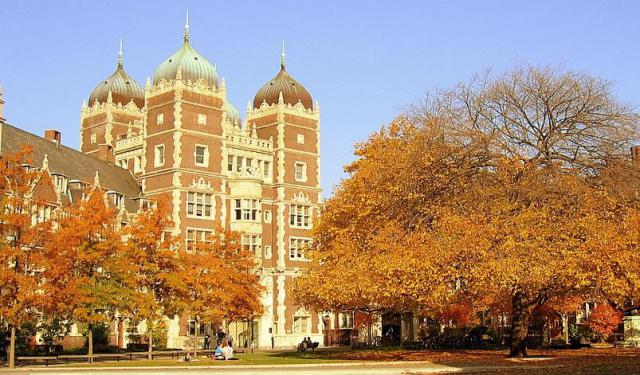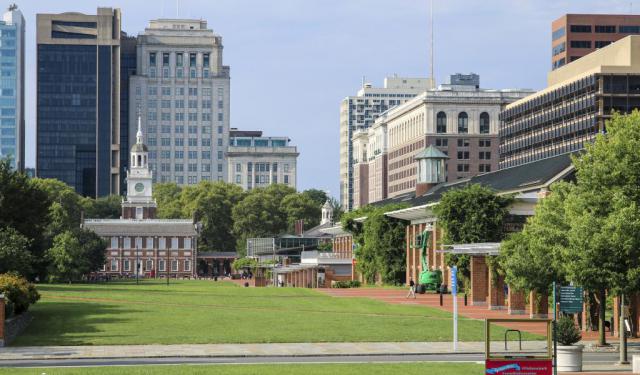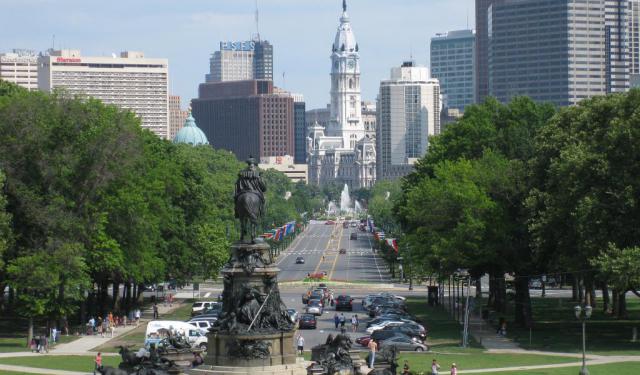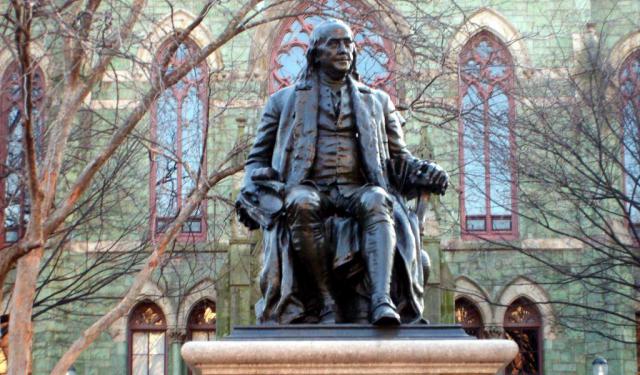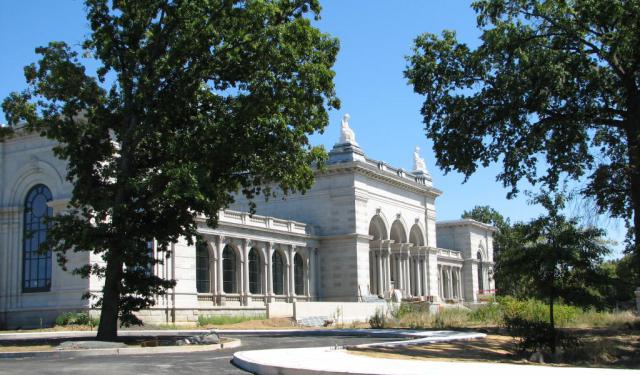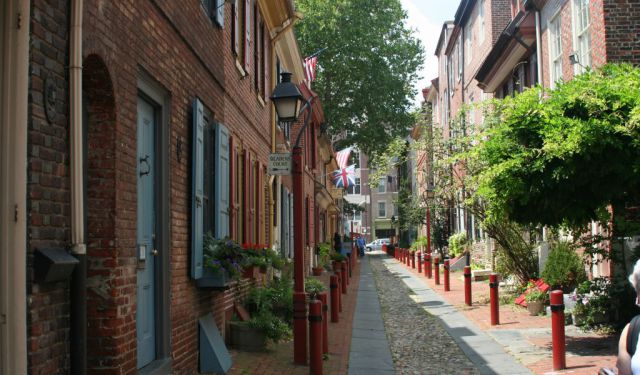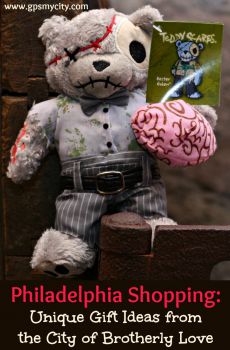Rocky Movie Sites Walking Tour (Self Guided), Philadelphia
There's hardly any other character, fictional or real, as iconically Philadelphian as Rocky. Indeed, this American sports drama franchise, centered on the boxing career of Rocky Balboa, released in 1976, has become synonymous with and arguably done more for the city of Philadelphia than anyone else since Ben Franklin.
The cultural phenomenon was created by Sylvester Stallone, who wrote, directed and starred in the movie, and had actually spent his formative years in Philadelphia, too. The city is featured prominently in all of the six Rocky sequels and spin-offs, pretty much like a stand-alone character.
The Rocky Steps, 72 stone stairs of the Philadelphia Museum of Art, is surely one of those places that die-hard fans wouldn't wanna miss for the world – a chance to run up, humming “Gonna Fly Now,” and then raising one's fists in the air, reaching the top. At the bottom of the stairs they can pose for a picture with Rocky Statue, the triumphant bronze sculpture originally commissioned for Rocky III, towering nearly 10 feet tall.
The Bonwit Teller & Co. department store, whose exterior appears in Rocky II, albeit no longer in residence, is yet another prominent site, much as Rittenhouse Square, a popular spot through which Rocky and Adrian, his wife, strolled after finding out they were going to become parents.
One can also try and re-enact Rocky's iconic training montage, running through the Italian Market, the nation’s oldest and largest working outdoor market, in a hope that the local vendors would waive and toss them fruit just as they did in the film.
And if one wants to eat, Rocky-style, they can always grab a cheesesteak at Pat's King of Steaks, or check out, for a more substantial dinner option, Adrian's Restaurant (Victor Cafe in reality, one of the oldest eateries in town) featured in Rocky Balboa, Creed, and Creed II.
For a true taste of Rocky's Philly, the City of Brotherly Love that has never been ashamed to root for an underdog, follow in the footsteps of the Italian Stallion with the help of our self-guided walking tour.
The cultural phenomenon was created by Sylvester Stallone, who wrote, directed and starred in the movie, and had actually spent his formative years in Philadelphia, too. The city is featured prominently in all of the six Rocky sequels and spin-offs, pretty much like a stand-alone character.
The Rocky Steps, 72 stone stairs of the Philadelphia Museum of Art, is surely one of those places that die-hard fans wouldn't wanna miss for the world – a chance to run up, humming “Gonna Fly Now,” and then raising one's fists in the air, reaching the top. At the bottom of the stairs they can pose for a picture with Rocky Statue, the triumphant bronze sculpture originally commissioned for Rocky III, towering nearly 10 feet tall.
The Bonwit Teller & Co. department store, whose exterior appears in Rocky II, albeit no longer in residence, is yet another prominent site, much as Rittenhouse Square, a popular spot through which Rocky and Adrian, his wife, strolled after finding out they were going to become parents.
One can also try and re-enact Rocky's iconic training montage, running through the Italian Market, the nation’s oldest and largest working outdoor market, in a hope that the local vendors would waive and toss them fruit just as they did in the film.
And if one wants to eat, Rocky-style, they can always grab a cheesesteak at Pat's King of Steaks, or check out, for a more substantial dinner option, Adrian's Restaurant (Victor Cafe in reality, one of the oldest eateries in town) featured in Rocky Balboa, Creed, and Creed II.
For a true taste of Rocky's Philly, the City of Brotherly Love that has never been ashamed to root for an underdog, follow in the footsteps of the Italian Stallion with the help of our self-guided walking tour.
How it works: Download the app "GPSmyCity: Walks in 1K+ Cities" from Apple App Store or Google Play Store to your mobile phone or tablet. The app turns your mobile device into a personal tour guide and its built-in GPS navigation functions guide you from one tour stop to next. The app works offline, so no data plan is needed when traveling abroad.
Rocky Movie Sites Walking Tour Map
Guide Name: Rocky Movie Sites Walking Tour
Guide Location: USA » Philadelphia (See other walking tours in Philadelphia)
Guide Type: Self-guided Walking Tour (Sightseeing)
# of Attractions: 7
Tour Duration: 3 Hour(s)
Travel Distance: 6.3 Km or 3.9 Miles
Author: leticia
Sight(s) Featured in This Guide:
Guide Location: USA » Philadelphia (See other walking tours in Philadelphia)
Guide Type: Self-guided Walking Tour (Sightseeing)
# of Attractions: 7
Tour Duration: 3 Hour(s)
Travel Distance: 6.3 Km or 3.9 Miles
Author: leticia
Sight(s) Featured in This Guide:
- Rocky Steps
- Bronze Rocky Statue
- Bonwit Teller & Co.
- Rittenhouse Square
- Italian Market
- Pat's King of Steaks
- Adrian's Restaurant (Victor Cafe)
1) Rocky Steps
The famous set of 72 stone stairs leading to the Museum of Art in Philadelphia is widely known as the "Rocky Steps," owing its moniker to a memorable scene from the 1976 movie Rocky. Devoted fans of the film often reenact Rocky's iconic ascent, viewing it as a symbol of an underdog triumphing against all odds or an ordinary person rising to meet a challenge.
This scene metaphorically mirrors Sylvester Stallone's journey from foster care to homelessness, sleeping in a bus shelter. Yet, he clung to the story of Rocky, eventually securing the lead role and rising to Hollywood stardom.
Sylvester Stallone revealed that the iconic scene originated when the crew discovered the steps while on a tight budget location hunt at night. Surprisingly, boxer Joe Frazier, who had a cameo, claimed the scene was influenced by his training but wasn't given due credit for his impact on the film.
Originally, Stallone had envisioned Rocky carrying his dog Butkus up the stairs, but the large bull mastiff proved too heavy for the task. Nevertheless, the breathtaking view from the top of the stairs, offering a panoramic vista of Eakins Oval, the Benjamin Franklin Parkway, and Philadelphia City Hall, motivated him to reshoot the scene sans the dog.
Three decades later, in the 2006 film Rocky Balboa, Stallone revisited the concept and carried a smaller dog named Punchy to the summit of the stairs. The closing credits of Rocky Balboa feature a montage of numerous individuals running up the steps. In that same year, during the unveiling ceremony of the Rocky Statue at the base of the stairs, Philadelphia Mayor John Street acclaimed the Rocky Steps as one of the city's foremost tourist attractions and dubbed Stallone, a native New Yorker, as "the city's favorite adopted son."
This scene metaphorically mirrors Sylvester Stallone's journey from foster care to homelessness, sleeping in a bus shelter. Yet, he clung to the story of Rocky, eventually securing the lead role and rising to Hollywood stardom.
Sylvester Stallone revealed that the iconic scene originated when the crew discovered the steps while on a tight budget location hunt at night. Surprisingly, boxer Joe Frazier, who had a cameo, claimed the scene was influenced by his training but wasn't given due credit for his impact on the film.
Originally, Stallone had envisioned Rocky carrying his dog Butkus up the stairs, but the large bull mastiff proved too heavy for the task. Nevertheless, the breathtaking view from the top of the stairs, offering a panoramic vista of Eakins Oval, the Benjamin Franklin Parkway, and Philadelphia City Hall, motivated him to reshoot the scene sans the dog.
Three decades later, in the 2006 film Rocky Balboa, Stallone revisited the concept and carried a smaller dog named Punchy to the summit of the stairs. The closing credits of Rocky Balboa feature a montage of numerous individuals running up the steps. In that same year, during the unveiling ceremony of the Rocky Statue at the base of the stairs, Philadelphia Mayor John Street acclaimed the Rocky Steps as one of the city's foremost tourist attractions and dubbed Stallone, a native New Yorker, as "the city's favorite adopted son."
2) Bronze Rocky Statue
One of the three existing copies of the Rocky Statue can be found on a pedestal situated in a grassy area near the base of the steps leading to the Philadelphia Museum of Art. The other two copies are owned by Sylvester Stallone himself and are displayed at the Schomberg Studios Gallery in Denver, Colorado.
The original statue, crafted by sculptor A. Thomas Schomberg, stands at an impressive 10 feet (approximately 3 meters) in height and weighs a substantial 2 tons. It was initially placed on the Museum's steps briefly during the filming of Rocky III.
Following the release of the movie in 1982, a debate ensued between the Museum and the Art Commission of Philadelphia regarding the sculpture's artistic merit. City officials contended that it lacked the status of "art" and considered it more of a "movie prop." Consequently, the statue was relocated to the front of the Philadelphia Spectrum.
Subsequently, the Rocky statue returned to the Art Museum for the filming of Rocky V but was later moved back to the Spectrum. At some point during these transitions, it was replaced with a bronze inlay featuring footprints of Converse sneakers and the name "Rocky" above them.
In the year 2006, the Rocky statue was finally restored to its place at the Art Museum, where it remains today and is a popular spot for photographs. The unveiling ceremony, which took place on September 8, 2006, featured live music, the premiere of the first full trailer for Rocky Balboa, and a free screening of the original Rocky movie.
The original statue, crafted by sculptor A. Thomas Schomberg, stands at an impressive 10 feet (approximately 3 meters) in height and weighs a substantial 2 tons. It was initially placed on the Museum's steps briefly during the filming of Rocky III.
Following the release of the movie in 1982, a debate ensued between the Museum and the Art Commission of Philadelphia regarding the sculpture's artistic merit. City officials contended that it lacked the status of "art" and considered it more of a "movie prop." Consequently, the statue was relocated to the front of the Philadelphia Spectrum.
Subsequently, the Rocky statue returned to the Art Museum for the filming of Rocky V but was later moved back to the Spectrum. At some point during these transitions, it was replaced with a bronze inlay featuring footprints of Converse sneakers and the name "Rocky" above them.
In the year 2006, the Rocky statue was finally restored to its place at the Art Museum, where it remains today and is a popular spot for photographs. The unveiling ceremony, which took place on September 8, 2006, featured live music, the premiere of the first full trailer for Rocky Balboa, and a free screening of the original Rocky movie.
3) Bonwit Teller & Co.
For those who watched the movie Rocky II, there's a memorable scene where Rocky parks his newly purchased car on a bustling street corner not far from the iconic Philadelphia City Hall. He walks up to the display of jackets at Bonwit Teller & Company, a renowned high-end department store, and excitedly shows them to his wife, Adrian. He says, "Hey Adrian, check these out! Don't you think this coat would look great on you? What about this one? Think it would suit me? Look at this black one with a tiger on the back. Do you like animals? I love animals. Black is my favorite color. Should we buy them before someone else does? What do you say, Adrian?"
During the 1970s, Bonwit Teller & Company was a well-known department store chain known for its high-quality clothing and competitive salaries for its employees. Unfortunately, the company went out of business in 2000, likely due to financial reasons. However, the building of its Philadelphia branch and the surrounding area still exist and look much the same as they did back then.
In this scene, as part of his shopping spree, Rocky not only purchases his iconic black leather jacket with a tiger print on the back but also buys a fur coat for Adrian and expensive wristwatches, including one for his brother-in-law, Paulie.
During the 1970s, Bonwit Teller & Company was a well-known department store chain known for its high-quality clothing and competitive salaries for its employees. Unfortunately, the company went out of business in 2000, likely due to financial reasons. However, the building of its Philadelphia branch and the surrounding area still exist and look much the same as they did back then.
In this scene, as part of his shopping spree, Rocky not only purchases his iconic black leather jacket with a tiger print on the back but also buys a fur coat for Adrian and expensive wristwatches, including one for his brother-in-law, Paulie.
4) Rittenhouse Square
This beautiful, lush park, nestled among the throng of giant downtown buildings in the heart of the most fashionable neighborhood in Philadelphia, was named after Philly’s own Revolutionary war patriot, David Rittenhouse, in 1825. The present layout of the square, with walkways running diagonally and meeting in the center, emerged in 1913; many of the bronze statues here also date back to that period.
Apart from its historical and architectural heritage, however, Rittenhouse Square is mostly popular these days for its association with Rocky II film. In the movie, Rocky and Adrian stroll along the southeast corner of the square after they learn from the doctor that they’re going to have a baby.
The couple head south, towards the intersection of 18th Street and Locust Street. Those keen to discover the exact route they took, should look for the elegant Barclay Condominium (remember the line, “I never use ’em”). This stone-fronted building is seen just behind the Balboas when they stop to face each other. Back in the day, when the scene was shot, the Barclay had a green awning over its front entry way, which is now removed and replaced with a much grander, upscale frontage.
Curiously enough, young Sly, his brother Frank, and their parents used to live in Rittenhouse Square for real, during the late 1950s, at the Chateau Crillon Apartments. Also, according to a 1979 interview, Stallone actually stayed at the Barclay Hotel in between filming of Rocky II and Rocky III.
Apart from its historical and architectural heritage, however, Rittenhouse Square is mostly popular these days for its association with Rocky II film. In the movie, Rocky and Adrian stroll along the southeast corner of the square after they learn from the doctor that they’re going to have a baby.
The couple head south, towards the intersection of 18th Street and Locust Street. Those keen to discover the exact route they took, should look for the elegant Barclay Condominium (remember the line, “I never use ’em”). This stone-fronted building is seen just behind the Balboas when they stop to face each other. Back in the day, when the scene was shot, the Barclay had a green awning over its front entry way, which is now removed and replaced with a much grander, upscale frontage.
Curiously enough, young Sly, his brother Frank, and their parents used to live in Rittenhouse Square for real, during the late 1950s, at the Chateau Crillon Apartments. Also, according to a 1979 interview, Stallone actually stayed at the Barclay Hotel in between filming of Rocky II and Rocky III.
5) Italian Market
The South 9th Street Curb Market, commonly referred to as the Italian Market, is an open-air marketplace located in South Philadelphia. The historic rowhouses along the street are adorned with vibrant metal awnings that cover the sidewalks. On the street-level storefronts, you can find a variety of shops selling groceries, as well as cafes, restaurants, and bakeries. Many of the shop owners, predominantly of Italian heritage, used to reside right above their establishments, and some continue to do so.
Over the years, as the city has undergone urban renewal, the Italian Market has also evolved. It now boasts outdoor seating at charming cafes, high-end gift boutiques, and specialty gourmet stores, alongside its traditional vendors selling fresh produce, unique butchers, and cheese purveyors.
The Italian Market has also played a significant role in Philadelphia's cultural landscape. It gained additional prominence after being featured in the Rocky and Rocky II movies, particularly in the iconic running and training montage scenes. As Rocky jogged through the market, the market stall operators and passersby can be seen looking at him with amusement. Interestingly, in reality, they had no prior knowledge of the filming, and their expressions were genuine. The memorable moment when a stall owner tosses an orange to Rocky was entirely impromptu, as the vendor had no idea that a movie was being shot and that he would be part of it.
Furthermore, in the 2006 film Rocky Balboa, the titular boxer is depicted shopping at the Italian Market for supplies for his restaurant, Adrian's.
Over the years, as the city has undergone urban renewal, the Italian Market has also evolved. It now boasts outdoor seating at charming cafes, high-end gift boutiques, and specialty gourmet stores, alongside its traditional vendors selling fresh produce, unique butchers, and cheese purveyors.
The Italian Market has also played a significant role in Philadelphia's cultural landscape. It gained additional prominence after being featured in the Rocky and Rocky II movies, particularly in the iconic running and training montage scenes. As Rocky jogged through the market, the market stall operators and passersby can be seen looking at him with amusement. Interestingly, in reality, they had no prior knowledge of the filming, and their expressions were genuine. The memorable moment when a stall owner tosses an orange to Rocky was entirely impromptu, as the vendor had no idea that a movie was being shot and that he would be part of it.
Furthermore, in the 2006 film Rocky Balboa, the titular boxer is depicted shopping at the Italian Market for supplies for his restaurant, Adrian's.
6) Pat's King of Steaks
Pat's King of Steaks is a renowned restaurant located in Philadelphia, specializing in the preparation of cheesesteak sandwiches. Established in 1930, this restaurant was founded by the Olivieri brothers, Pasquale (Pat) and Harry. These two brothers are widely acknowledged as the originators of the iconic cheesesteak. Presently, the restaurant is under the ownership of Harry's grandson, Frank.
Legend has it that one day, the Olivieri brothers, who had previously focused on selling hot dogs, decided to diversify their lunch offerings. Pat entrusted Harry with the task of procuring affordable steak from the market. They proceeded to thinly slice the steak and grill it, along with finely chopped onions. The irresistible aroma of their creation attracted the attention of a regular customer, a cabdriver, who expressed a keen interest in trying this novel culinary creation. The brothers dubbed it a "steak sandwich," a moniker that would eventually evolve into the modern-day cheesesteak.
Since 1976, this iconic Philadelphia eatery has remained immensely popular, particularly among fans of the fictional boxer Rocky Balboa. In the film franchise, Pat's King of Steaks serves as the backdrop where Tony Gazzo takes Rocky for a meal. Even after several decades, Pat's continues to thrive and has the distinction of having a memorial plaque affixed to the pavement, commemorating the filming of the iconic motion picture Rocky on November 21, 1975.
It is worth noting the proper ordering procedure: After specifying the type of cheese you desire, which includes options such as Cheez Whiz, provolone, or American cheese, as well as opting for plain (no cheese), you should humorously employ the local parlance by declaring "wit" or "wit-out," indicating your preference for the inclusion or omission of onions, in a nod to the distinctive Philadelphia accent.
Legend has it that one day, the Olivieri brothers, who had previously focused on selling hot dogs, decided to diversify their lunch offerings. Pat entrusted Harry with the task of procuring affordable steak from the market. They proceeded to thinly slice the steak and grill it, along with finely chopped onions. The irresistible aroma of their creation attracted the attention of a regular customer, a cabdriver, who expressed a keen interest in trying this novel culinary creation. The brothers dubbed it a "steak sandwich," a moniker that would eventually evolve into the modern-day cheesesteak.
Since 1976, this iconic Philadelphia eatery has remained immensely popular, particularly among fans of the fictional boxer Rocky Balboa. In the film franchise, Pat's King of Steaks serves as the backdrop where Tony Gazzo takes Rocky for a meal. Even after several decades, Pat's continues to thrive and has the distinction of having a memorial plaque affixed to the pavement, commemorating the filming of the iconic motion picture Rocky on November 21, 1975.
It is worth noting the proper ordering procedure: After specifying the type of cheese you desire, which includes options such as Cheez Whiz, provolone, or American cheese, as well as opting for plain (no cheese), you should humorously employ the local parlance by declaring "wit" or "wit-out," indicating your preference for the inclusion or omission of onions, in a nod to the distinctive Philadelphia accent.
7) Adrian's Restaurant (Victor Cafe)
Set in a quiet residential neighborhood near the intersection of Dickinson and 13th Streets in Philadelphia is the charming Italian eatery, depicted in Rocky Balboa as Adrian’s Restaurant. In reality, the place is called Victor Cafe. As you stand facing the front, walk to the left and around the corner, and then down a few steps to see the back of the restaurant featured in the movie.
Contrary to its cinematographic counterpart (Adrian’s Restaurant, according to its signage and menu, was set up in 1995), the prototype venue operates since 1918. Inside, the restaurant appears just as intimate as it does in the film, save the boxing themed walls, which in real life are decorated with the impressive collection of operatic recordings, photographs and other music and opera memorabilia.
Chosen by the Rocky Balboa production in 2005, Victor Cafe had both its façade and interior specifically outfitted to appear as Rocky Balboa’s property. Named after his wife Adrian, the restaurant had pictures of her hung on the walls, alongside photos of Rocky’s boxing career highlights as well as some real-life fixtures from Victor Cafe. Victor's owner Greg DiStefano said Stallone liked the vibe of the place so much that he decided to incorporate more of the Cafe’s décor into Rocky’s fictional restaurant than was planned originally.
The concept for Rocky's owning a restaurant was based on real-life boxing legend, Jack Dempsey, who opened a restaurant in Manhattan, New York in the 1930s. It is also due to this connection that Rocky is seen wearing a navy blue shirt with the large white DEMPSEY print across the chest beneath his wine-colored sport coat when he works at Adrian’s.
Contrary to its cinematographic counterpart (Adrian’s Restaurant, according to its signage and menu, was set up in 1995), the prototype venue operates since 1918. Inside, the restaurant appears just as intimate as it does in the film, save the boxing themed walls, which in real life are decorated with the impressive collection of operatic recordings, photographs and other music and opera memorabilia.
Chosen by the Rocky Balboa production in 2005, Victor Cafe had both its façade and interior specifically outfitted to appear as Rocky Balboa’s property. Named after his wife Adrian, the restaurant had pictures of her hung on the walls, alongside photos of Rocky’s boxing career highlights as well as some real-life fixtures from Victor Cafe. Victor's owner Greg DiStefano said Stallone liked the vibe of the place so much that he decided to incorporate more of the Cafe’s décor into Rocky’s fictional restaurant than was planned originally.
The concept for Rocky's owning a restaurant was based on real-life boxing legend, Jack Dempsey, who opened a restaurant in Manhattan, New York in the 1930s. It is also due to this connection that Rocky is seen wearing a navy blue shirt with the large white DEMPSEY print across the chest beneath his wine-colored sport coat when he works at Adrian’s.
Walking Tours in Philadelphia, Pennsylvania
Create Your Own Walk in Philadelphia
Creating your own self-guided walk in Philadelphia is easy and fun. Choose the city attractions that you want to see and a walk route map will be created just for you. You can even set your hotel as the start point of the walk.
University of Pennsylvania Walking Tour
As America's first university, The University of Pennsylvania (aka Penn or Upenn, for short) has a history stretching back to the mid-18th century, closely bound with the city's colonial past and the birth of the United States. Initially, this Ivy League institution emerged as the College of Philadelphia, one of the nine colonial colleges chartered before the US Declaration of... view more
Tour Duration: 2 Hour(s)
Travel Distance: 2.2 Km or 1.4 Miles
Tour Duration: 2 Hour(s)
Travel Distance: 2.2 Km or 1.4 Miles
Philadelphia Introduction Walking Tour
The sixth largest city in the United States and the largest in the Commonwealth of Pennsylvania, Philadelphia is a dynamic city heaped with old-world charm and contemporary infrastructure. Notable for its rich history, primarily as the birthplace of "life, liberty, and the pursuit of happiness."
Often called Philly, Philadelphia is also known as the City of Brotherly Love – a... view more
Tour Duration: 2 Hour(s)
Travel Distance: 2.3 Km or 1.4 Miles
Often called Philly, Philadelphia is also known as the City of Brotherly Love – a... view more
Tour Duration: 2 Hour(s)
Travel Distance: 2.3 Km or 1.4 Miles
Franklin Parkway Walking Tour
Benjamin Franklin Parkway is a scenic boulevard running through the cultural heart of Philadelphia. Named for America's Founding Father, Benjamin Franklin, this mile-long tree-lined parkway is lined with several notable sights and world-class museums.
At its heart lies Logan Circle, a charming green space centered around a picturesque fountain. This spot can provide a refreshing break on... view more
Tour Duration: 2 Hour(s)
Travel Distance: 2.6 Km or 1.6 Miles
At its heart lies Logan Circle, a charming green space centered around a picturesque fountain. This spot can provide a refreshing break on... view more
Tour Duration: 2 Hour(s)
Travel Distance: 2.6 Km or 1.6 Miles
Benjamin Franklin's Philadelphia
Benjamin Franklin's journey to becoming one of the most influential figures in Revolutionary America began when he, as a teenager, ventured from a Puritan family in Boston to Philadelphia. This city would not only become his home but also a stage for his remarkable life as a writer, printer, philosopher, postmaster, scientist, inventor, statesman, and diplomat. His life epitomizes the... view more
Tour Duration: 2 Hour(s)
Travel Distance: 2.5 Km or 1.6 Miles
Tour Duration: 2 Hour(s)
Travel Distance: 2.5 Km or 1.6 Miles
Fairmount Park Historical Houses Walking Tour
Fairmount Park, Philadelphia's oldest park, established since 1867, is also the city's largest municipal park, sprawling over 2,000 acres adjacent to the banks of the Schuylkill River. The park grew out of the Lemon Hill estate of Henry Pratt, whose land was originally owned by Robert Morris, signer of the Declaration of Independence.
In 1972, the park was placed on the National... view more
Tour Duration: 2 Hour(s)
Travel Distance: 4.7 Km or 2.9 Miles
In 1972, the park was placed on the National... view more
Tour Duration: 2 Hour(s)
Travel Distance: 4.7 Km or 2.9 Miles
Philadelphia Old City Walking Tour
King Charles II of England, while seriously indebted to Admiral Sir William Penn, settled his debt in 1681 by granting lands in America to William Penn, the Admiral's Quaker son. A thorn in the King's side, young Penn sailed to America, where he envisioned a utopian society based on tolerance and founded Philadelphia, the "City of Brotherly Love."
The Old City Center, the... view more
Tour Duration: 2 Hour(s)
Travel Distance: 3.2 Km or 2 Miles
The Old City Center, the... view more
Tour Duration: 2 Hour(s)
Travel Distance: 3.2 Km or 2 Miles
Useful Travel Guides for Planning Your Trip
Philadelphia Souvenirs: 13 Unique Gift Ideas from the City of Brotherly Love
Looking for a great gift while visiting Philadelphia? Famous for its history, arts and culture, championship sports teams, and award-winning food and drink, Philadelphia is a top-rated shopping destination. Here, you'll find an amazing selection of items to choose from - something uniquely...
The Most Popular Cities
/ view all
